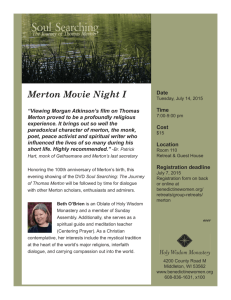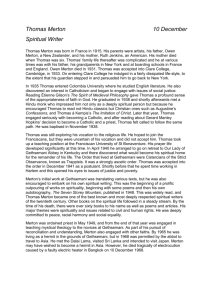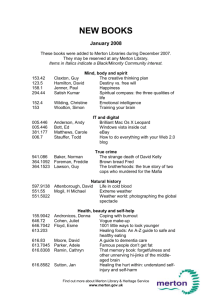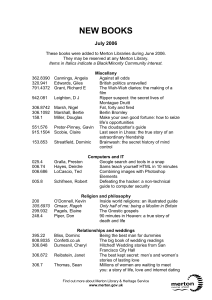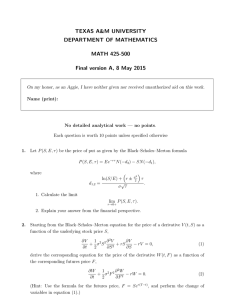SF/ORE, WOODS, Dtr,SERT Nofebook,Maa
advertisement
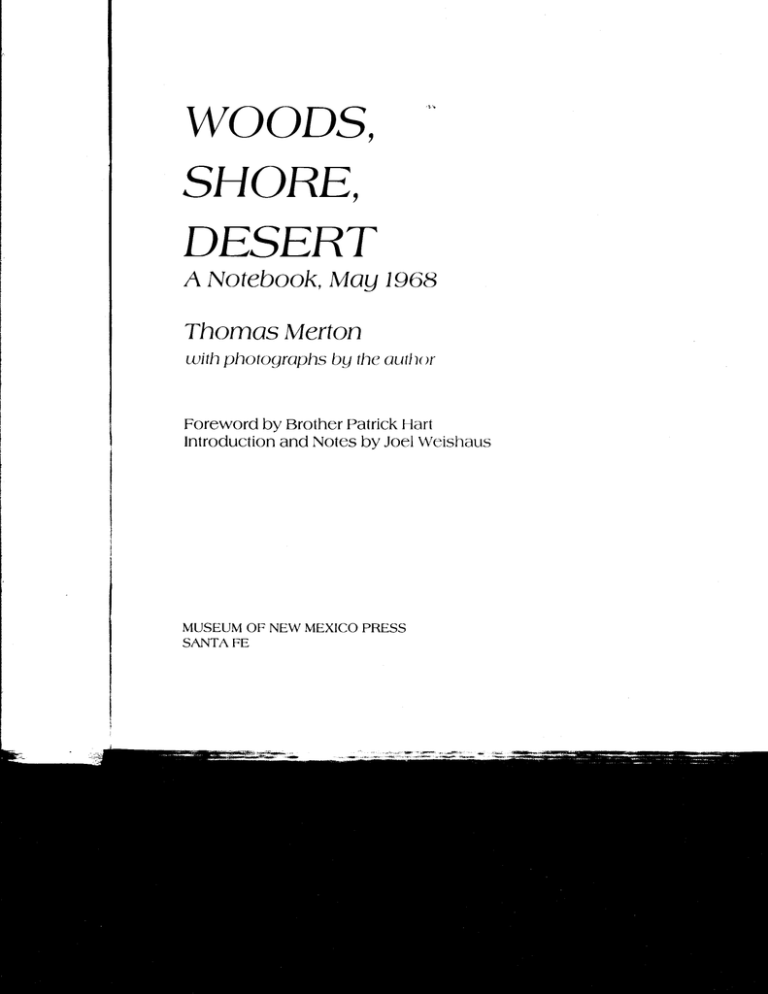
WOODS,
SF/ORE,
Dtr,SERT
A Nofebook,Maa 1968
Thomas Merton
tuith photographs bu the autlxx
Foreword by Brother Patrick Hart
Introduction and Notes by Joel Weishaus
MUSEUM Otr NEW MEXICO PRESS
SANTA FE
I
I
i
L trr"
h*.
fn <n;
Se
'r
p, old
Fb,o
Feie"
l**'
t
I
trlerv
Fnre
prol
Itre
|,".t.
INTRODUCTION
Fs- ot
F""
it=."
bles.
F
ot'
tsrnv
Fh of
Fe
Ls
Ers of
FM.rbod il
i
During May of l96a Thomas Merton took a trip to California and New Mexico, his first extended, unattended time away from the Abbey of Gethsemani
in twenty-six years. Later the same year he was to make a longer sojourn, one
that would take him to Asia, where, in Bangkok, Thailand, on December lO,
196a, he would touch a faulty electric fan in his room and pass from this world.
So many biographies and critiques of Thomas Merton3 life and work have
been written that I feei it redundant to go into any details exclusive of the period
covered by the book at hand. But a very brief summary of his life before May
l96a may be helpful.
Thomas Merton was born in Prades, France, on January 31, 1915. His father
was an artist from New Zealand; his mother, also an artist, an American. She
died when Tom was six, after which the boy traveled with his father or was
shuttled between relatives. When he was sixteen his father died, leaving supervision of Tom to his godfather. Merton finished public school in England, then,
after a summer in ltaly, entered Clare College, Cambridge. But his godfather
"decided that the temptations of Cambridge undergraduate life were too compelling."t In December 1934 Merton arrived in New York to live with relatives
on Long Island while attending Columbia University. He received his B.A. in
lg3a, and an M.A. in English literature the following year.
On Decembrer lo, 1941, the young fun{oving man who seemed destined for
a successful academic career took a train to Kentucky, where he disappeared
behind the walls of the medieval Trappist monastery, the Abbey of Our Lady
IX
of Gethsemani. Behind those walls, during the next twenty-seven years,
Thomas Merton, living under a strict rule of silence, lvrote more than fifty
books: essays, journals, biographies, poetry. His views as a civil rights and
anti-war advocate became known throughout the world. And, along with his
concerns with secular issues, Merton was perhaps the most important Christian mystic of our time.
In the early lgms, while keeping up his prodigious writing and reading and
his normal duties as priest and monk, Merton took on the demanding job of
Master of Novices. All this combined to threaten seriously his rather fragile
health, as well as his spiritual progress. ln 1960 he was granted permission to
spend some time in seclusion in a small cinder-block house on the monasterys grounds. By August 1965, finally relieved of his teachin$ responsibilities,
he was able to spend most of his time living the eremitic life. But the popularity of his books was bringing more and more pilgrims to the gates of Gethsemani to see the famous monk. on May 6, 1968, 'seeking a more solitary place
for his hermitage, with the approval of his Abbot,"2 Merton began a fifteen-day
trip to the California coast and New Mexico desert.
ln 1978 I came upon an article in NeL{, Mexico Magazine entitled "Thomas
Merton's New Mexico.€ Along with the text were a few photographs Merton
had taken while visiting there. Upon my inquiring, the Thomas Merton Studies Center in Louisville, Kentucky, informed me that a series of photographs
Merton had taken in California and New Mexico, along with a notebook, were
possibly available for publication. A few months later, after more communication, I received a copy of the notebook.
Woods, Shore, Desert: ANotebook, MaA rc6a begins with three quotes from
th]e Astauakra Gita, following the direction of Mertonb development.4 Several
Roman Catholic priests had written books suggesling a more ecumenical view
of the world, but Merton was one of the few who were actually integrating the
teachings of other religions into their spiritual disciplines, 'reading the calligraphy of snow and rock.'His teachers included Christian Desert Fathers, alon$
with Taoist philosophers, Buddhist Zen Masters and L-amas, Hindu sadhus and
Jewish Hasids. Here he returns "to sources,'preparing to speak'of something
new to which you might not yet have access."
On May 6 he flew from Louisville, via Chicago and San Francisco airports,
to Eureka, California. Based at Our Lady of the Redwoods Monastery, Whitethorn, California, he ventured along the coast'with a small box of sun-kissed
seedless raisins." Although still tentative, Merton is moving toward "an experiment in openness." Standing on the Pacific shore, looking hopefully to Asia,
hearing the "faint cry of a lamtr'on the mountain side muffled by sea wind,"
breathing in the pungent world, breathing out the poetry of his vision . . . Bear
Harbor, Needle Rock, Mattold valley, wild irises "three or four feet high," calla
lilies "growing wild among the ferns of a stream bank," roses, "and a lot of
flowering shrubs that I cannot name." And always the redwoods "indescribably beautiful."
ln 1963 John Howard Griffin asked Dom James Fox, Abbot of the Abbey of
Gethsemani, if he could photograph Thomas Merton for a documentary archive. It was during the shooting session that Merton became interested in
camera. According to Griffin, "The camera became in his hands, almost immediately, an instrument of contemplation.'s'His concept of aesthetic beauty differed from that of most men. Most would pass by dead roots in search of a
rose. Merton photographed the dead tree root or the texture of wood or whatever crossed his path . . . seeking not to alter their life but to preserve it in his
emulsions.6 Not like Tennyson, who plucked the "flower in the crannied wall
. . . roots and all." More like Ryokan, who wrote:
The grasses oJ thegarden,ThegJall,
And lie as theg Jall.?
Photography is a way of framing wholeness so that suchness reveals itself;8
it "never makes the mistake of trying to turn from the material to the immaterial in hopes of conveying'spirituality.'€ And Merton was a man of the earth.
His eyes danced with shapes, textures, gestures of rock and woody plants;
"illusions that are not normally admitted on the scene."to He was not a'photographer.'tror him, the camera was merely another tool "for dealing with things
everybody knows about but isn't attending to.""
After a restless night in san Francisco, Merton flew to Albuquerque, New
Mexico, the way to the Monastery of christ in the Desert, l3o miles north of
the city. He had published a collection of parables and sayings of the fourthcentury Christian Deserl trathers;r2 but it is in his book Thoughts in Solitude
that Merton most eloquently addresses contemporary problems in "the holy
desert":
XI
The desert Fathers believed that the wilderness had been created as supremely valuable in the eyes of God precisely because it had no value to
men. The wasteland was the land that could never be wasted by men because it offered them nothing. There was nothing to attract them. There
was nothing to exploit.
He goes on to lament:
When man and his money and machines move out into the desert, and
dwell there, not fighting the devil as Christ did, but believing in his promise
of power and wealth, and adoring his angelic wisdom, then the desert itself
moves eveD,ryvhere. Ever)'vvhere is desert. Ever),ryvhere is solitude in which
man must do penance and fight the adversary and purify his own heart in
the grace of God.13
Those words were written in the early morning gloom of Gethsemani. Now,
motoring through the sunlight of New Mexico, there is the stark beauty of the
Sangre de Cristo (Blood of Christ) Mountains, and "mesas, full rivers, cottonwoods, sagebrush, high red cliffs, pinon pines," and "miles of emptiness.'
At the Monastery of Christ in the Desert, by day he walked up the canyon
observing "a fat mountain ringed with pillared red cliffs, ponderous as the great
Babylonian movie palaces of the l92os, but far bigger." At night he awakened
with stomach cramps and ran "barefooted down the cold pebble path to the
hur with the toilet in it not knowing whether the toilet would flush."
What he was reading he wove into the fabric of what he was living. Thus
"the curvature of space around Mount Analogue" is penetrated by the calls of
the crows in New Mexico'as he "pick[sl up the amice to begin to vest for concelebration." The connection. The path forever lengthening, the Vision approaching, " The Clear Light'and reality itself."r4
This book would have been impossible to bring to publication without the
encouragement, patience and research of Dr. Robert E. Daggy, Curator of the
Merton Studies Center. I would also like to thank Br. Patrick Hart of the Abbey
of Gethsemani; Fr. Blase Schauer of Liturgy in Santa Fe; Br. Brendan, Librarian, College of Santa Fe; Petrita Lara of the New Mexico State Library; Fr.
Aelred Wall; Sister Veronique Geeroms of Redwoods Monastery; the Villagra
xll
I
t
I
I
t
I
F.,
Book Shop; Br. Peter Buck, Br. Stephen Herman and Margaret West of Our
Lady of Guadalupe Abbey, Pecos, New Mexico; and Denis Hines, W. H. Ferry,
Peter Nabokov, Mary Worman, Robert and priscilla Bunker, Alex Traube, and
tsreto
lenbe-
Craig Eyrich.
[t**
I
I
it-o
t
trrus€
Fni6elf
furrhich
lmn
in
I
I
fi
xorr'.
fvor
I
rrre
conon-
F'
l
i-,1'on
lrcgr.ut
pkened
rc rhe
fr
i**
I
catrs of
ftu con
l*n
ap
[,..
lortrr"
ilroev
Li
Fn.
bn':
Fr.
[nt"s'"
i
I
t
I
I
:
?
I'
I
f
f
JoelWeishaus
Santa tre, NeLD Mexico

